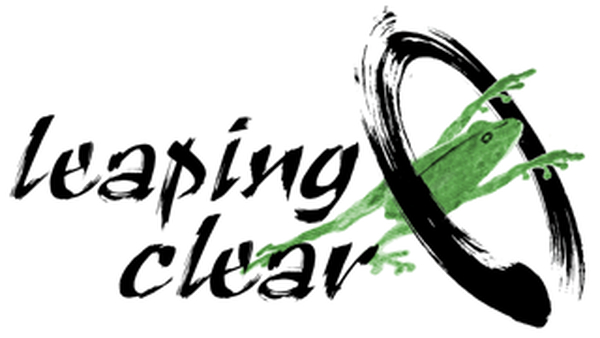John Savoie
Old Waters New
古池や 蛙飛び込む 水の音
That is to say:
furu ike ya
kawazu tobikomu
mizu no oto
Or once again:
old pond
frog jumps in
splasshhh ...
Basho’s seemingly simple haiku has acquired a to-be-or-not-to-be stature among the iconic lines of Japanese literature, engendering deep and nearly inexpressible feelings on time, stillness, action, and aftermath. Those words have been set for over three hundred years, yet their creative impulse still lives and ripples forth.
Consider the facing haiga as living call-and-response. Much remains the same, repeating key terms from beginning, middle, and end: old, jumps, splash. Yet much has changed in period, place, medium, and word. Seventeenth-century Japan gives way to twenty-first-century American Midwest. Spare, fluid sumie (Basho drew his own) has sped up yet also thickened to a fast-snap, densely pixelated triptych.
The words matter most of all, and among so few changes, each change matters immensely. Placid, meditative pond, perhaps flecked with algae to resemble a monkish cha, enlarges to a dusky yet shimmering, free-flowing, Heraclitan river. Most crucially, man displaces frog, expanding the human element from perception and contemplation (still present, to be sure) to full-bodied participation—resolved, active, exuberant. The responsive haiku merges doing and reflecting as if to vow, with a wink, “I will be my own frog.” Would Basho himself take that jump? In his playful youth, why not? And even in solemn age he would, I think, smile to see it done.
John Savoie
My eclectic meditative practices shift among the usual suspects: waking, waiting, dream recall, coffee, dog, reading when there's light enough, memory work in the dark, intention, prayer, poetry read, recalled, or newly rising. What is too often neglected in meditative studies is the transition from the various practices to the active lives we lead. What will you do with your meditation? How will it inform and energize your life? This piece begins with a centuries-old meditation before 'leaping clear,' literally, then circling back again to the meditative word.
In contemporary terms “Old Waters New” is a poetry-image-nonfiction hybrid. The more traditional terms, though, are haiku-haiga-haibun, the last of these notable here because the reflection follows, rather than precedes, the haiku.
I was fortunate to grow up on the banks of the St. Joseph River in southwestern Michigan between Buchanan and Berrien Springs, and every once in a while I manage to return. Collaborators on this project include: Julie Soules, original pics; Boyd Nutting, key grip; Cheryl Nutting, keeper of the kayaks; and Tori Walters, image crafting.


